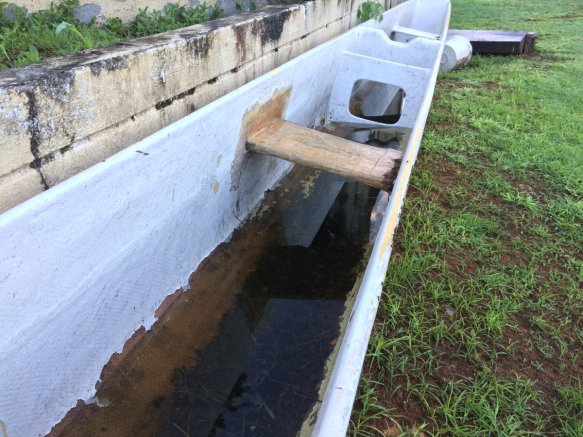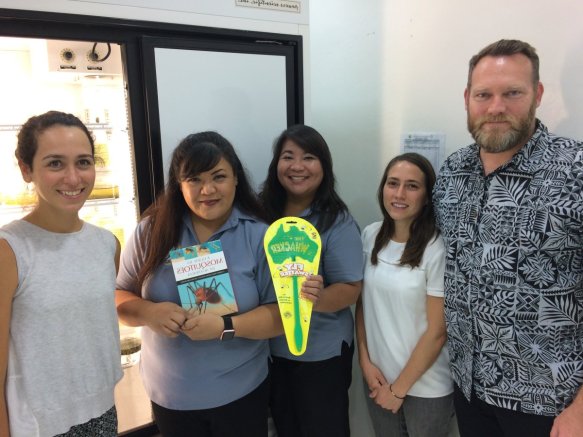
The following is a collection of almost 100 links to news stories, resources, references and recommendations associated with mosquito-borne Zika virus and the current outbreak in the Americas.
What is Zika? What are the health threats and why an outbreak now?
Zika virus (CDC). Essential resource. Click.
Zika virus (WHO). Essential resource. Click.
Zika virus spreading explosively, says World Health Organisation (The Guardian). Coverage of statement by WHO Director General that the explosive outbreak of Zika virus in the Americas as “deeply concerning” and that an emergency committee has been convened. Click.
WHO Director-General summarizes the outcome of the Emergency Committee regarding clusters of microcephaly and Guillain-Barré syndrome (WHO). Click.
Zika virus declared a global health emergency by WHO (ABC News). Click.
Zika Virus Spreads to New Areas — Region of the Americas, May 2015–January 2016 (CDC). Click.
WHO early response to Zika virus praised by Australian experts (The World Today). Click.
First report of autochthonous transmission of Zika virus in Brazil (Memórias do Instituto Oswaldo Cruz). Click.
How a Medical Mystery in Brazil Led Doctors to Zika (New York Times). A summary of how health officials investigating a spike in cases of birth defects put together the link to a mosquito-borne disease. Click.
Explainer: where did Zika virus come from and why is it a problem in Brazil? (The Conversation). A good, brief summary of the emergence of Zika virus in Brazil and the health risks it poses. Click.
Zika virus outbreak: What you need to know (New Scientist). A good summary of issues associated with Zika virus outbreak. Click.
Zika outbreak: What you need to know (BBC). A good summary of what is known of Zika virus and its health risks. Click.
What to Know About Zika Virus (The Atlantic). Click.
Zika virus, explained in 6 charts and maps (Vox). Useful collection of infographics on Zika virus, current and historic outbreak distributions and health impacts. Click.
An Illustrated Guide To The Zika Outbreak (Huffington Post). Click.
Why it’s wrong to compare Zika to Ebola (The Conversation). Whats the difference between Ebola and Zika viruses? What are the implications of outbreaks and declarations of public health emergencies? Click.
Zika fever: panic won’t help us (The Guardian). Editorial highlighting the horror and unexpectedness of the Zika virus outbreak in Brazil and how we should move forward in mosquito control. Click.
What we still don’t know about Zika virus (Mashable). There are plenty of gaps in our understanding of Zika virus. Click.
The human cost of Zika is clear, but will Brazil’s economy suffer too? (The Conversation). Outbreaks of infectious diseases can have greater impacts than the human illness alone. Click.

Zika virus and its vectors
Mosquitoes: The Zika vector (Radio National). Why do we need to know how many mosquitoes can spread Zika virus and what is it about the mosquitoes that do that make them such an important pest? Click.
Natural-born killers: mosquito-borne diseases (SMH). What is it that makes mosquitoes such effective vectors of pathogens? Click.
Zika Virus in Gabon (Central Africa) – 2007: A New Threat from Aedes albopictus? (PLOS Neglected Tropical Diseases). Click.
Oral Susceptibility of Singapore Aedes (Stegomyia) aegypti (Linnaeus) to Zika Virus (PLOS Neglected Tropical Diseases). Click.
Aedes (Stegomyia) albopictus (Skuse): A Potential Vector of Zika Virus in Singapore (PLOS Neglected Tropical Diseases). Click.
Potential of selected Senegalese Aedes spp. mosquitoes (Diptera: Culicidae) to transmit Zika virus (BMC Infectious Diseases). Click.
Genetic Characterization of Zika Virus Strains: Geographic Expansion of the Asian Lineage (PLOS Neglected Tropical Diseases). Click.
Molecular Evolution of Zika Virus during Its Emergence in the 20th Century (PLOS Neglected Tropical Diseases). Click.

The spike in cases of microcephaly and its suspected links to Zika virus infection of those pregnant has been raising greatest concern. (Image: BBC)
Zika virus, pregnancy and microcephaly
Possible Association Between Zika Virus Infection and Microcephaly — Brazil, 2015 (CDC). Click.
Microcephaly in Brazil: is it occurring in greater numbers than normal or not? (Virology Down Under). Great post highlighting the gaps in our understanding of links between microcephaly and Zika virus. Click.
Proving that the Zika virus causes microcephaly (The Conversation). What questions must be answered to confirm a link between Zika virus and microcephaly. Click.
Interim Guidelines for Pregnant Women During a Zika Virus Outbreak — United States, 2016 (CDC). Click.
CDC: Link between Zika, microcephaly looks “stronger and stronger” (Reuters). Click.
Facts about Microcephaly (CDC). What are the impacts, causes and treatments associated with microcephaly? Click.
Zika virus outbreak raises Pacific, Americas travel concerns for pregnant women (Stuff NZ). Implications for those travelling in Pacific while pregnant. Click.
Safely avoiding mosquito bites when pregnant (Mosquito Research and Management). My tips on safe and effective avoidance of mosquito bites while pregnant. Click.
13 Things Pregnant Women Should Actually Know About Zika (Buzzfeed). Some good advice, most importantly, don’t panic. Don’t even panic if you’re pregnant and bitten by a mosquito. Click.

Zika virus and the threat to Australia
Does Zika virus pose a threat to Australia? (The Conversation). An overview of why, and why not, Zika virus poses a risk to Australia. Click.
The Threat to Australia: The Rise Of Zika Virus (Popular Science). Article from 2014 highlighting potential risk to Australia of Zika virus following detection of imported cases. Click.
Zika Virus Explained: Aussie Mozzies, Bali Risks And Pregnancy (Huffington Post). Good summary of risks posed to Australia and Australian travellers. Click.
Zika virus: Risk of a widespread outbreak in Australia ‘low’, experts say (ABC News). A summary of reasons why there won’t be a major outbreak of Zika virus in Australia. Click.
Zika talkback with Dr Karl on Triple J (ABC). I join Dr Karl for talkback on Zika virus, advice to travellers and the risks of outbreak in Australia. Click.
Zika virus alert (NSW Health). Factsheet on Zika virus and risk to NSW. Click.
Little chance of Zika outbreak in NSW (Sky News). There is unlikely to be a major outbreak of Zika virus across Australia’s most populated region. Click.
Two Aussies confirmed with Zika as US records first case of virus transmitted through sex (The Mercury). Click.
Zika virus mosquitoes found in Sydney: Airport increases insecticide spraying of incoming passengers (Daily Telegraph). Report of recent detection of Aedes aegypti at Sydney airport by Department of Agriculture and Water Resources. Click.
Queensland announces $1.4 million program to fight Zika. (Brisbane Times). Queensland authorities announce response plan; increasing monitoring and research into Zika virus. Click.
Zika virus entering Australia
Zika virus and Travel Alert for Australians (Smart Traveller). Click.
Imported Zika Virus Infection from the Cook Islands into Australia, 2014 (PLOS Current Outbreaks). Click.
Zika Virus Infection Acquired During Brief Travel to Indonesia (Am J Trop Med Hyg). Published report from 2013 of Australian traveller exposed to Zika virus in Indonesia. Click.
Aussie diagnosed with Zika after Bali monkey bite, experts warn of missed cases (SMH). Report of 2015 case os suspected infection following monkey bite in Bali. Click.
Zika Virus Infection In Australia Following A Monkey Bite In Indonesia (Southeast Asian Journal of Tropical Medicine and Public Health). Abstracted from published case report of suspected Zika virus infection following monkey bite. Click.
Six cases of Zika virus in Australia last year as pregnant women warned not to travel (SMH). Summary of recent imported cases of Zika virus infection in Australian travellers. Click.
Health Department confirms WA Zika case (The West Australian). Report of imported case of Zika virus infection in returning traveller to Western Australia. Click.
Zika virus: Queensland woman, child confirmed as contracting illness (ABC News). Imported cases of Zika virus infection with travellers returning to QLD from El Salvador. (ABC News). Click.
Zika outbreaks in the Pacific
Zika Virus Outside Africa (Emerging Infectious Diseases). Summary of outbreaks in regions outside Africa with specific discussion of the first outbreak in Pacific. Click.
Zika Virus Outbreak on Yap Island, Federated States of Micronesia (New England Journal of Medicine). Click.
Zika virus: following the path of dengue and chikungunya? (The Lancet). Good paper, including useful maps, of activity of three critical mosquito-borne pathogens. Click.
Rapid spread of emerging Zika virus in the Pacific area (Clinical Microbiology and Infection). Publication reporting on the 2013 outbreak of Zika virus in the Pacific. Click.
Notes on Zika virus – an emerging pathogen now present in the South Pacific (Australian and New Zealand Journal of Public Health). An article assessing the risks of Zika virus to New Zealand. Although no suitable vectors exist there, a relatively larger volume of infected travellers would be expected to occur given the strong links to Pacific Islands. Click.
Tonga declares Zika outbreak (Sky News). Zika is impacting more regions than the Americas in 2016. Click.
Australia to help Pacific fight Zika (SBS News). How can Australian authorities take their expertise in mosquito monitoring, mosquito control and vaccine development to assist outbreak of Zika virus. Click.

Zika virus and sex: An unusual route of transmission
Probable Non–Vector-borne Transmission of Zika Virus, Colorado, USA (Emerging Infectious Diseases). First documented case of transmission of Zika virus through direct contact between people. Click.
Potential Sexual Transmission of Zika Virus (Emerging Infectious Diseases). Publication from 2015 on suspected sexual transmission of Zika virus. Click.
Zika virus infection ‘through sex’ reported in US (BBC). Suspected case of sexually transmitted Zika virus in Texas in 2016. Click.
CDC: To avoid Zika exposure, consider no sex (The Washington Post). Coverage of CDC guidance on avoiding sexual transmission risk of Zika virus. Click.
Interim Guidelines for Prevention of Sexual Transmission of Zika Virus — United States, 2016 (CDC). Click.
Zika: Why the virus isn’t an STI despite being passed on after sexual contact (Independent). Only where sex is the predominant route of transmission, and the infection is maintained in the human population by sexual transmission, is a pathogen considered a STI and that definition does not apply to Zika virus. Click.
Brazil finds Zika in saliva, urine; expert warns against kissing (SMH). Detection of Zika virus in saliva and urine doesn’t necessarily mean these are pathways of transmission. Authorities advising against kissing? Click.
Zika and the 2016 Rio Olympics
Zika Outbreak Means It Is Now Time To Cancel Rio Olympics (Forbes). Is the threat of Zika virus really so great that the Rio Olympics should be cancelled? Click.
NYU Bioethicist, Amid Zika Threat, Wants to Reschedule Rio Olympics: ‘What the Hell’s the Difference?’ (New York Magazine). With so many unanswered questions, and little confidence the outbreak is under control, is it really ethical to go ahead with the Rio Olympics? Click.
Brazil minister says no plans to cancel Rio Games (AP). Click.
Zika virus will not hamper Rio Olympics says IOC president Thomas Bach (ABC News). Click.
IOC says it will issue advisory on Zika virus spreading across South America ahead of Rio Olympics (ABC News). Click.
Zika crisis and economic woes bring gloom to Brazil’s Olympic buildup (The Guardian). Click.
Zika scare: Olympic athletes need mosquito nets as Bushman sponsors team (SMH). Click.
Zika Virus Rio Olympics: How Australian Athletes Will Fight Potential Infection (Huffington Post). Click.
Bushman named as official insect repellent of Australian Olympic team (mUmBRELLA). One of Australia’s leading mosquito repellent manufacturers to support the athletes and officials travelling to Rio Olympics. Click.

Battling mosquitoes and the Zika virus outbreak
How Can We Slow The Epidemic Of Zika Infections? (Forbes). Now that the outbreak of Zika virus has been documented, what strategies are available to slow the spread and increasing numbers of cases? Click.
The world needs a Zika vaccine: Getting one will take years (STAT). We won’t have a Zika virus vaccine anytime soon. Here is an explanation why. Click.
Brazil Zika virus: ‘War’ declared on deadly mosquitoes (BBC). How are authorities battling the outbreak of Zika virus in Brazil? Click.
Mosquito Wars Update: Would You Choose GMO ‘Mutants,’ Pesticides Or Dengue And Zika Viruses? (Forbes). The outbreak of Zika virus has focused the attention of health authorities on options for future mosquito-borne disease management strategies. Click.
Brazil sends in 200,000 soldiers to stop the spread of the Zika virus outbreak which has seen huge numbers of babies born with small heads and cast a shadow over the Olympics (Daily Mail). Click.
Here’s what it will take to stop the Zika virus (Vox). Summary of critical issues to address to better understand and stop the Zika virus outbreak. Click.
Curbing Zika Virus: Mosquito Control (Popular Science). Well supported article on options for mosquito control and mosquito-borne disease management. Click.
7 ways the war on Zika mosquitoes could be won (New Scientist). Overview of the different approaches available to beat the Zika virus outbreak and mosquito-borne disease more generally. Click.
In Australia, a New Tactic in Battle Against Zika Virus: Mosquito Breeding (New York Times). Overview of emerging technologies developed in Australia to battle dengue but could be incorporated into the Zika virus response. Click.
Zika virus: pesticides are not a long-term solution says leading entomologist (The Guardian). Spraying insecticides can sometimes be a blunt instrument unless there is an understanding of where best to target mosquito populations. Click.
Zika outbreak revives calls for spraying with banned pesticide DDT (STAT). Outbreaks of mosquito-borne disease often prompt calls to return to DDT as teh insecticide of choice to control mosquitoes. Click.
Insecticide to be sprayed inside planes from Zika affected regions (The Guardian). Aircraft should already be treated with insecticides to stop movement of mosquitoes from one country to the next, hitchhiking in planes but efforts have been boosted in wake of Zika virus fears. Click.
Be careful what you wish for
Let’s Kill All the Mosquitoes (Slate). Emergence of another mosquito-borne disease, another opportunity to call for killing mosquitoes off completely. Click.
Why Eradicating Earth’s Mosquitoes To Fight Disease Is Probably a Bad Idea (Vice). Don’t be so sure that eradicating mosquitoes is the answer, or at least it won’t have consequences. Click.
Would it be wrong to eradicate mosquitoes? (BBC). What could be the unexpected consequences of sending mosquitoes extinct? Click.
Sights on world’s deadliest animal as Zika virus spreads (The New Daily). Wiping out all mosquitoes is probably a bad idea but perhaps we could knock off just a few and greatly improve the health of the planet? Click.
There’s one (or more) in every crowd…
Is Zika Virus the Next Tool For Forced Sterilization, Vaccination and Depopulation? (Activist Post). Oh boy. Click.
Health experts slam anti-vaxxers’ zika virus conspiracy theory as ‘absurd’ (News.com.au). No, immunization programs didn’t cause the Zika virus outbreak and increases in microcephaly. Click.
Concerning Correlation: GMO Mosquitoes Caused Zika Virus Outbreak? (21st Centuray Wire). Bonkers. Click.
No, GM Mosquitoes Didn’t Start The Zika Outbreak (Discover Magazine). Wonderful article debunking one of the most common conspiracy theories associated with the Zika virus outbreak. Click.
Got any more useful links? Tweet them through to me!
Photo of sign from Zika Forest taken from here.





































